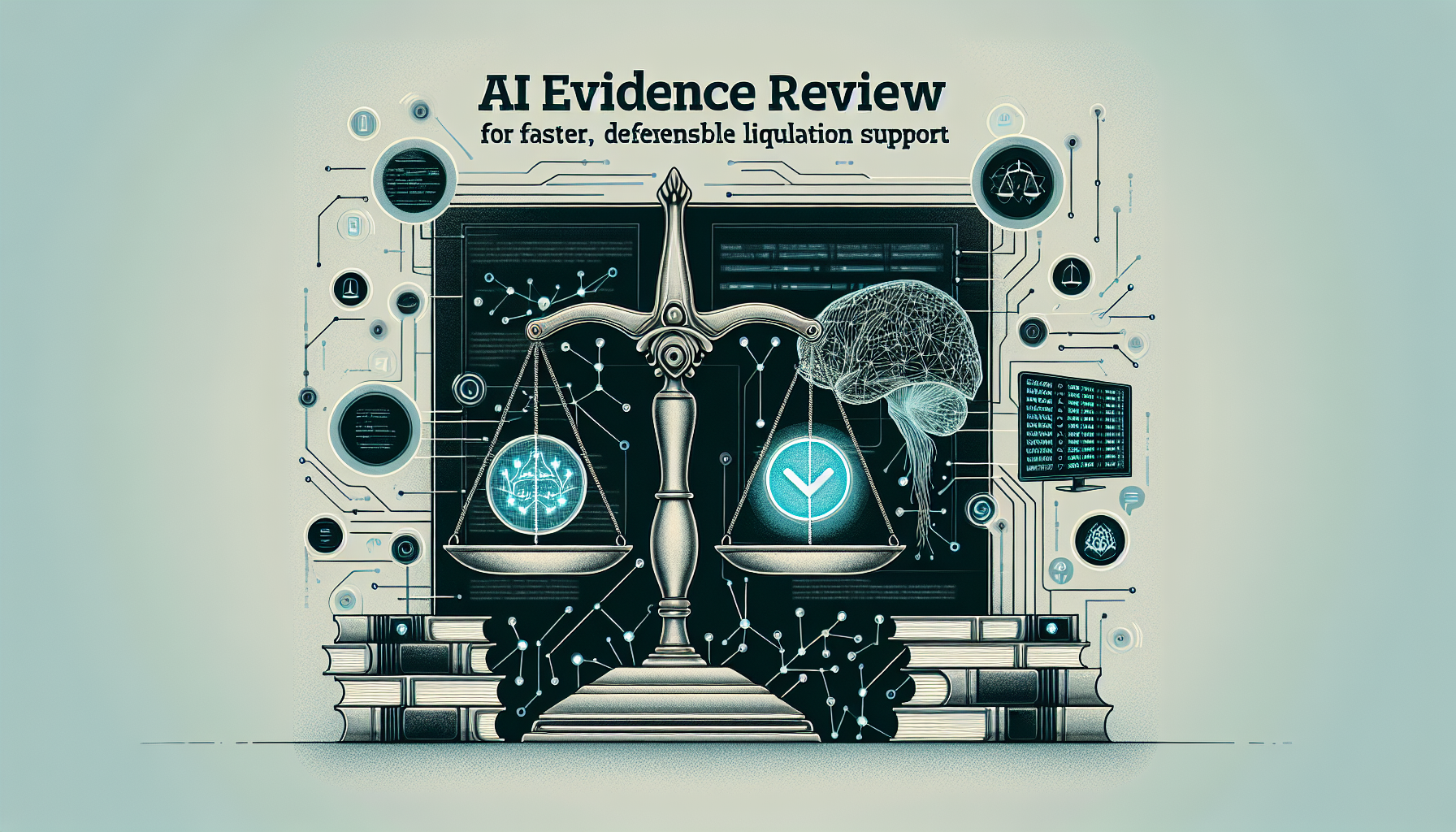AI-Powered Evidence Review in Litigation Support: Faster, Defensible, and Client-Centered
Discovery is the budget engine of most litigation—and the pain point. AI-powered evidence review promises to tame exploding data volumes, cut costs without sacrificing quality, and surface the facts that win cases sooner. This week’s article breaks down how modern AI tools, workflow design, and Microsoft 365 integrations can streamline your litigation support from legal hold to production, while strengthening defensibility and client satisfaction.
Table of Contents
- What Is AI-Powered Evidence Review and Why It Matters
- Core Capabilities: From Preservation to Production
- Building a Defensible, Auditable AI Review Workflow
- Practical Example: Microsoft 365 + Purview + Review Platform + Copilot
- Collaboration & Knowledge Capture with Microsoft 365 Copilot
- Compliance, Security & Risk Mitigation
- AI Review Platform Comparison
- Workflow Optimization, Metrics & Cost Control
- Ethical & Regulatory Considerations
- Future Trends in AI for Evidence Review
- Conclusion
What Is AI-Powered Evidence Review and Why It Matters
AI-powered evidence review applies machine learning and modern automation to the entire eDiscovery lifecycle. Beyond simple keyword search, AI identifies patterns, prioritizes likely-relevant materials, reduces duplication, and flags sensitive or privileged content. The result: more accurate decisions earlier, fewer reviewer hours, and clearer fact development. For litigators and litigation support teams, this translates into improved predictability, reduced risk, and a stronger negotiating position on proportionality and scope.
Core Capabilities: From Preservation to Production
Best-in-class AI review brings multiple capabilities together. Understanding how they fit allows legal teams to architect processes that scale.
- Legal hold and targeted collection across common data sources (Microsoft 365, Teams, SharePoint, OneDrive, email, chat, and structured data).
- Processing and normalization (de-NISTing, deduplication, metadata extraction, text and language normalization).
- Early case assessment (ECA) and prioritization (clustering, thematic analysis, conversation threading, near-duplicate detection).
- Technology Assisted Review (TAR), including Continuous Active Learning (CAL) to iteratively refine relevance predictions as attorneys review.
- Multimodal enrichment (transcription for audio/video, image OCR) to make all evidence searchable.
- Entity and relationship extraction (people, organizations, dates, topics) to build timelines and identify key custodians.
- Automated redaction, PII/PHI detection, and suggestion of privilege indicators for quality control.
- Defensible production workflows (bates stamping, format normalization, privilege logs, and audit trails).
Identify Sources ↓ Preserve & Collect (Legal Holds; M365, Email, Chat, Files) ↓ Process & Normalize (Dedup; Metadata; Text Extraction) ↓ AI Analytics (Threading; Near-Dups; Clusters; Entities; Transcripts) ↓ CAL/TAR Review (Attorney Feedback → Model Improves → Prioritization) ↓ QC & Privilege (Sampling; Redactions; PII Controls) ↓ Production & Reporting (Load Files; Bates; Privilege Log; Audit)
Building a Defensible, Auditable AI Review Workflow
Courts expect proportionality and reasonableness. An AI-driven workflow should be transparent, measured, and repeatable.
Best practice: Document your end-to-end methodology—selection of tools, training sets, sampling approach, statistical validation, quality thresholds, and exception handling. Strong process documentation is your first line of defense if discovery methods are challenged.
Key steps
- Define scope and objectives: issues, date ranges, custodians, languages, and special data types (voice, images, chats).
- Choose the review strategy: seed set training, CAL for ongoing attorney-in-the-loop prioritization, or hybrid approaches.
- Perform sampling and validation: measure precision/recall, use elusion tests on presumed non-responsive sets, and maintain statistical confidence levels.
- Layer QC controls: privilege checks, sensitive data detection (PII/PHI), and second-level review for high-risk categories.
- Maintain auditable logs: chain of custody, admin actions, search terms and decisions, and model versions.
Practical Example: Microsoft 365 + Purview + Review Platform + Copilot
Below is a practical, platform-agnostic pattern using Microsoft 365 as your data backbone, Microsoft Purview eDiscovery (Premium) for holds and collection, a dedicated AI review platform (e.g., RelativityOne, Everlaw, DISCO, or Reveal) for TAR/CAL, and Microsoft 365 Copilot to accelerate attorney work product.
Scenario
A regional firm defends a fast-moving employment class action involving email, Teams chats, and HR documents. The client uses Microsoft 365. The firm needs quick insight and an efficient, defensible review.
Step-by-step
- Preserve and collect in Purview: Create a case, place legal holds on key custodians (Exchange mailboxes, OneDrive, Teams). Use targeted searches to identify likely relevant content and add to a review set for export.
- Process into an AI review platform: Export collected data from Purview and load into your chosen review platform. Enable analytics (threading, near-duplicates, clustering). Run automated transcription for recorded meetings or voicemails if present.
- Start CAL/TAR: Assign a senior reviewer to code a seed set of documents across clusters. Turn on continuous active learning—high-scoring documents bubble up for priority review; low-scoring sets are spot-checked.
- QC and privilege safeguards: Enable PII detection and privilege indicators. Require second-level review for “hot” and “privileged” tags. Run elusion testing to verify that low-scoring documents do not contain missed relevant content.
- Summarize findings with Copilot: After initial waves of review, export hot documents or notes to a secure SharePoint site. Use Microsoft 365 Copilot in Word to generate a chronology, themes, and issues outline. In Teams, use meeting transcripts and Copilot to capture decisions and to-do lists following case strategy sessions.
- Iterate and produce: Continue review until validation metrics meet agreed thresholds. Generate productions with bates numbers and create an automated privilege log. Keep all audit reports for defensibility.
Outcome: A defensible process reduces review volume by 40–60%, attorneys get a high-quality factual narrative early, and the client sees clear time and cost savings.
Collaboration & Knowledge Capture with Microsoft 365 Copilot
AI review is not just about culling; it is about turning evidence into strategy. Microsoft 365 Copilot helps legal teams synthesize insights securely inside their tenant.
- Case brief drafting in Word: Insert key excerpts and ask Copilot to propose an issue outline aligned to pleadings, then refine with attorney judgment.
- Deposition prep in OneNote: Paste selected chat threads; prompt Copilot to identify inconsistencies and draft topic areas for examination.
- Meeting synthesis in Teams: Use transcripts and Copilot to extract commitments, risks, and follow-ups after strategy meetings; push tasks to Planner.
- Timeline building in Excel/Loop: Paste entities (people, dates, events) exported from the review platform and ask Copilot to normalize and order them into a litigation chronology.
Tip for defensibility: Treat Copilot-generated summaries as drafts. Attorneys should verify quotes, cite sources, and ensure all assertions are supported by reviewed documents.
Compliance, Security & Risk Mitigation
Security and privacy must be integral to your AI review architecture.
- Data minimization: Collect narrowly and stage sensitive data separately. Suppress non-relevant PII where possible.
- Tenant-aligned AI: Prefer tools that operate within your enterprise environment (e.g., Microsoft 365, private cloud review platforms) to avoid consumer-grade data exposure.
- Encryption and access controls: Enforce MFA, SSO, role-based access, IP restrictions, and encryption at rest/in transit. Log and monitor all admin and reviewer actions.
- Vendor diligence: Verify security assessments, incident response, data residency options, and subcontractors. Execute DPAs and ensure cross-border transfer mechanisms are in place where needed.
- Retention and deletion: Apply retention labels and deletion schedules post-matter to limit long-tail risk.
For Microsoft-centric environments, Microsoft Purview helps manage legal holds and governance, while sensitivity labels and Data Loss Prevention (DLP) policies reduce inadvertent disclosures during and after review.
AI Review Platform Comparison
| Platform | Strengths for AI-Powered Review | Notable AI/Automation Features | Security & Compliance Highlights | Best-Fit Matters |
|---|---|---|---|---|
| RelativityOne | Enterprise-scale review with robust analytics and integrations. | TAR/CAL, email threading, near-duplicates, conceptual clustering, entity extraction, translation. | Enterprise controls, granular permissions, robust auditing; verify vendor certifications. | Large, complex, multi-custodian litigations and investigations. |
| Everlaw | Attorney-friendly UI with strong storytelling features. | Predictive coding, clustering, timeline tools, audio/video transcription, translation. | Enterprise security and audit trails; verify certifications and data residency options. | Matters emphasizing collaboration and narrative-building. |
| DISCO | Speed-focused review with intuitive analytics. | AI-driven relevance, threading, near-duplicates, visualization tools. | Enterprise-grade controls; confirm certifications and privacy commitments. | Fast-moving litigations and rolling productions. |
| Reveal | Advanced analytics, investigation features, and visualizations. | CAL, concept search, social network analysis, sentiment, image analysis. | Enterprise controls and logging; validate vendor attestations. | Regulatory investigations, fraud, and complex data types. |
| Microsoft Purview eDiscovery (Premium) | Legal holds, targeted collection, review set staging in Microsoft 365. | Custodian management, search, review sets; export to review platforms. | In-tenant governance, DLP, sensitivity labels, audit; confirm regional options. | Microsoft 365-centric matters; defensible collection and governance. |
Note: Always validate current features, certifications, and data residency capabilities directly with the vendor.
Workflow Optimization, Metrics & Cost Control
A sustainable AI review program tracks measurable outcomes and continuously improves.
Operational tactics
- Iterative culling: Use threading, near-duplicates, and CAL early to shrink the review universe before full-scale review.
- Hot set acceleration: Prioritize “high-scoring” clusters for early case assessment and strategy.
- Privilege automation: Use AI to suggest privilege indicators; maintain a standardized privilege log schema to reduce last-minute scrambles.
- Domain expertise loops: Keep senior attorneys coding small, representative sets to steer the model; assign bulk to trained reviewers once the model stabilizes.
- Template playbooks: Reuse validated sampling plans, QC checklists, and production templates across matters.
Key metrics (track weekly)
- Reviewer throughput (docs/hour) and cost per document/GB.
- Precision and recall estimates; elusion rates in low-scoring populations.
- Reduction from de-duplication, threading, and near-duplicate suppression.
- False-positive privilege rate; second-level reversal rates.
- Cycle time from collection to substantial completion.
Ethical & Regulatory Considerations
Attorneys must safeguard confidentiality and maintain technological competence when using AI in discovery.
- Duty of competence: Understand at a high level how TAR/CAL works, what sampling shows, and what your validation numbers mean.
- Confidentiality and privilege: Restrict use of consumer AI tools for client data. Keep review and summarization inside enterprise-grade, governed environments.
- Supervision: AI suggestions are not determinations—attorney oversight remains essential, especially on privilege and responsiveness.
- Transparency and cooperation: Be prepared to explain your process in meet-and-confers, including TAR/CAL use and validation steps, as appropriate.
- Recordkeeping: Preserve logs, protocols, and validation reports to support defensibility under discovery rules and prevailing best practices.
Ethical insight: Generative AI can draft summaries and timelines, but do not permit it to “create” facts. Every assertion must trace back to reviewed documents, with clear citations. Treat AI outputs as accelerators—not arbiters—of legal judgment.
Future Trends in AI for Evidence Review
- Multimodal review at scale: Unified analysis of text, audio, video, and images with better transcription and object detection.
- Agentic workflows: AI agents coordinating rote tasks—like batching, QC reminders, and privilege log drafting—under attorney supervision.
- Context-aware redaction: Smarter redaction that understands when names or numbers are sensitive based on matter context.
- Integrated case analytics: Seamless handoffs between review platforms and litigation prep tools to auto-build exhibit lists, witness files, and thematic maps.
- Granular governance: Deeper integration with enterprise data governance (e.g., Microsoft Purview) to apply sensitivity labels and access policies throughout the review lifecycle.
Conclusion
AI-powered evidence review is no longer experimental—it is the most defensible way to move faster with less risk in modern discovery. By pairing Microsoft 365 governance with a capable AI review platform and operationalizing Copilot for synthesis, firms can cut costs, meet deadlines, and deliver sharper insights to clients. Start with a defensible workflow, measure relentlessly, and iterate. Your next case can be faster, clearer, and more predictable.
Want expert guidance on improving your legal practice operations with modern tools and strategies? Reach out to A.I. Solutions today for tailored support and training.





